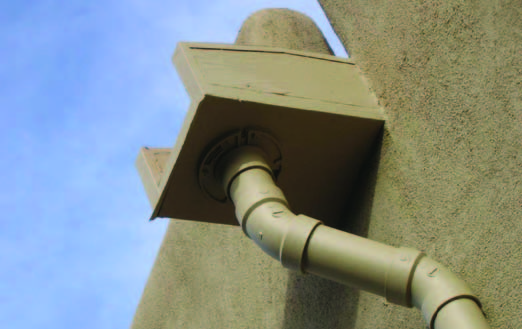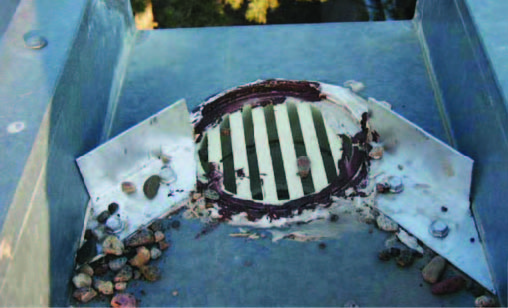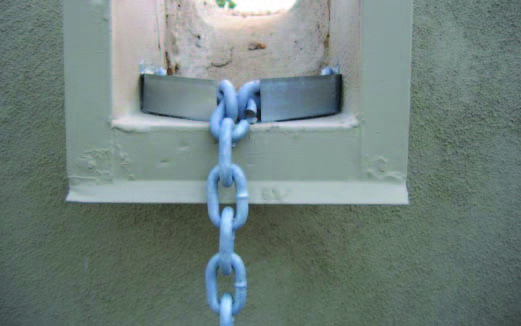The PermaDesign Weblog, with Nate Downey and Melissa McDonald!
Roof-Reliant Landscaping™ Step 16B: Water Conveyance - Important Tips
Important Tips
Drainage mistakes close to the foundation of a wall should be avoided no matter what the cost. When installing your funnel drains:
• Be sure water flows away from buildings. When water collects against a wall, it can create expensive structural damage and mold problems.
• Do not cut corners by eliminating the liner. Without it, you will harvest much less water, and the roof water that you do not harvest may soak into the soil at the foundation of your home.
• Ensure that the connections between parts and materials are tight and secure. Although conveyance piping does not technically move water under pressure, the force under a canale can be substantial.

Figure 8-5: A toilet flange can connect a canale to a downspout.
For many people, all of the work described in the previous section about constructing a funnel drain may seem like too much labor and too much expense for a system that cannot capture all of the rainwater during high winds and/or large storm events. An alternative to a funnel drain is directly connecting downspouts to the bottom of canales.
There are a number of ways to direct roof water from a canale toward a storage tank. One common way, shown in Figure 8-5, is to install a toilet flange in the bottom of the canale, seal the flange, connect the flange to a downspout and partially dam up the outer edge of the canale. (Shown in Figure 8-6). The partial dam helps direct water into the drain at the top of the downspout. In the event that the drain gets clogged with debris, however, water can spill over the dam and flow off the canale to the ground below. This reduces the chance of creating a potentially damaging standing pool of water on the roof.

Figure 8-6: Partial dams installed on both sides of a drain directs the flow of rainwater.
There are other potential risks in connecting a downspout to a canale. A weak connection between canale and downspout can leak into the roof and walls of your structure. If undetected or neglected, significant structural and/or mold damage can occur. In addition, ice, especially on the north side of a structure, can prevent snowmelt from running off of buildings. Standing water and heavy icicles, along with the freeze-thaw conditions associated with winter weather, can cause significant damage either to a roof or its associated walls.
Another common method of directing roof water from a canale, presented in Figure 8-7, is to use a rain chain to direct water downward.

Figure 8-7: A rain chain is a simple but effective way to direct water downward from a canale.
In-Wall Drainpipes
Some downspouts, especially those associated with roof drains, are built into the walls of structures and are called “in-wall” drainpipes. Such systems are often installed for aesthetic reasons to keep the downspouts out of sight.
In-wall drainpipes are not only more difficult to fix, but also problems are more difficult to detect because they are so well hidden. Even small, undetected leaks can cause major damage to a wall in a relatively short time. In residential applications, these in-wall systems are relatively uncommon. However, in commercial applications, especially for tall buildings with flat roofs, roof drains associated with in-wall drainpipes are currently a typical method for controlling roofwater runoff at the vertical-drop point.
01/22/2016 | (2) Comments










Comments
Thankyou for sharing this post, It is worth reading.
where do I order the #8 rain chain for canales